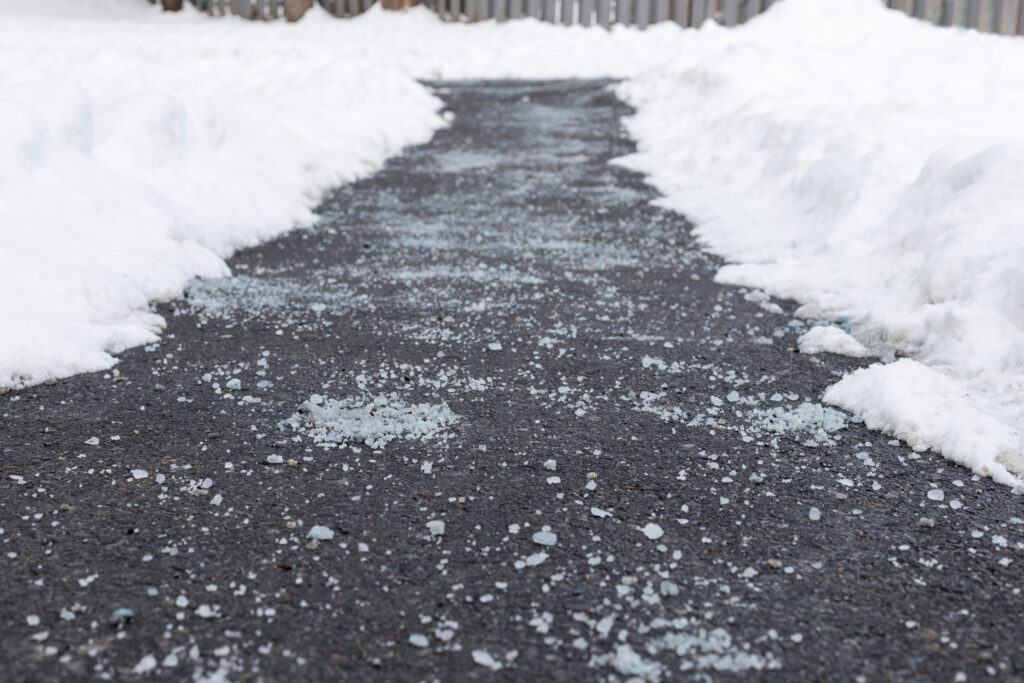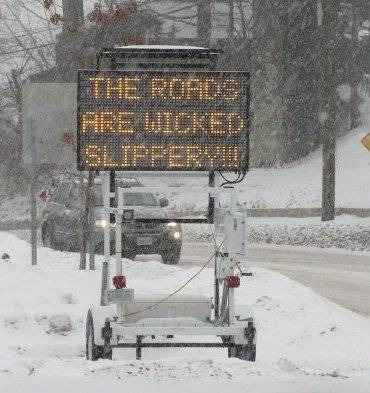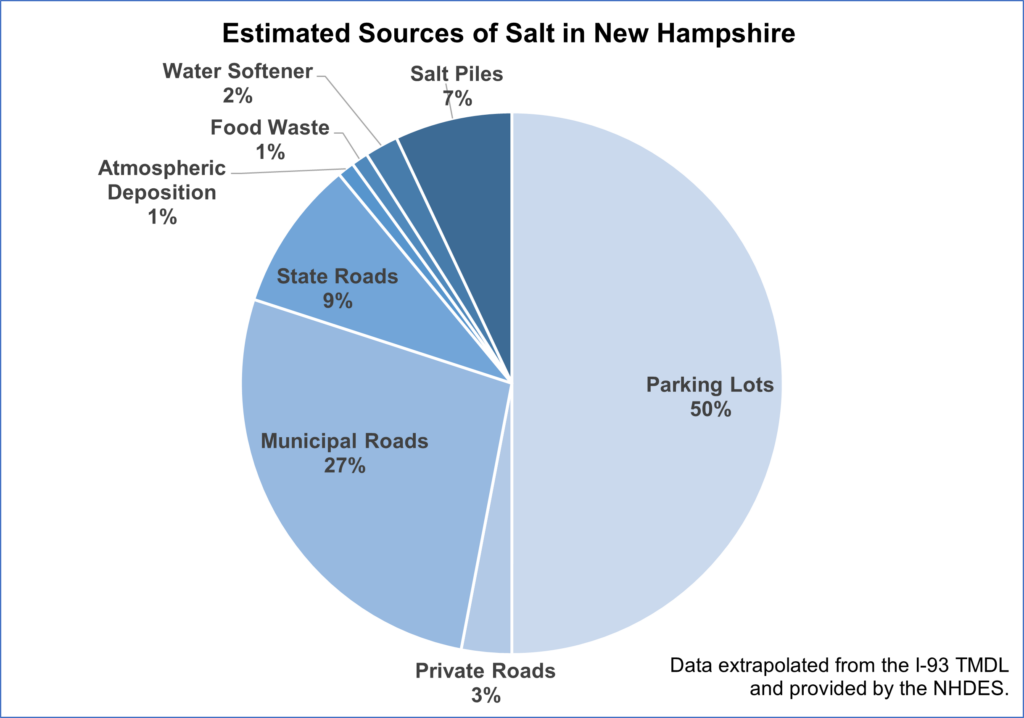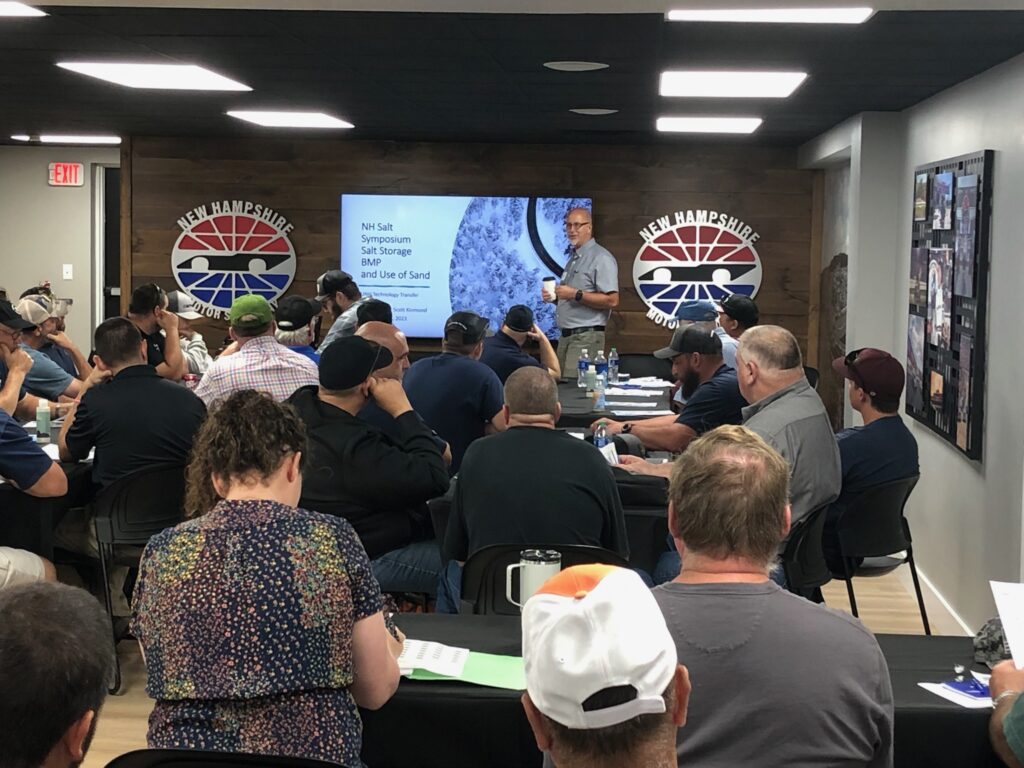By Beth MacBlane
Across the globe and especially here in the Northeast, a dramatic increase in sodium chloride concentrations in freshwater has been documented due, in large part, to road salt application. Originating as a practice in New Hampshire in the 1940s, the use of de-icing salts in the region has increased exponentially. As the population grew, so too did the number of vehicles and amount of impervious surfaces such as roads and parking lots, fueling our addiction to road salt. Today, an estimated 25 million tons of salt is scattered on roads across the United States annually.
While de-icing salt application is essential for winter travel and public safety, it comes at a cost. Sodium chloride (NaCl) – the most common type of road salt – ends up in surface and groundwater through stormwater runoff, posing a public and environmental health concern. Additionally, once it enters the environment, it is difficult to remove – just one teaspoon of salt permanently pollutes five gallons of water.
“With our New England winters, road salt pollution is a critical issue to our region,” said Christina Stringer, NEIWPCC director of Wastewater and Onsite Programs. “We know we are pumping a lot more salt into our rivers, lakes, and streams than we used to, and this is having negative results on aquatic ecosystems and our drinking water.”
Road salt works by lowering the freezing point of water, making ice melt even when the temperature is below water’s normal freezing point of 32 degrees. When salt dissolves in water, it breaks into two ions, sodium and chloride, which then make their way into the environment. Not surprisingly, research shows that waterbodies in dense urban areas with more runoff from roads and parking lots contain higher concentrations of sodium and chloride than their less developed counterparts.

Sodium Chloride: More Than Just a Grain of Salt
The physical and chemical properties of water are affected by both sodium and chloride, impacting ecosystem health. Chloride is highly soluble, mobile and there is no natural process to break it down or metabolize it. High chloride levels can lead to oxygen depletion in water, limiting a necessary component for aquatic life. Additionally, chlorides can form a dense, oxygen-deficient layer in the water column that can be harmful to fish and other aquatic life and inhibit spring turnover in some lakes.
Winter road de-icing also impacts wildlife: from freshwater fish and aquatic bugs whose growth is slowed from the salty runoff, to deer and moose who like to lick the salt on roadways making them more prone to vehicle collisions. Chlorides can also poison smaller mammals and birds, and make pets sick if ingested. Plants, too, are negatively affected by salty soils along roadsides. These soils retain less water and nutrients, making them less habitable and more susceptible to erosion and runoff.
Another concern with salt pollution is its impact on and removal from drinking water. As road salt runs off to nearby waterways and infiltrates the ground, it can contaminate drinking water wells, aquifers and reservoirs. Beyond the salty taste, elevated levels of sodium in drinking water can pose a problem for people on a low-sodium diet and, more seriously, for those with certain medical conditions such as high blood pressure.
Additionally, sodium chloride can eat away at essential infrastructure. Bridges, roads, culverts, pipes, plumbing and vehicles can be corroded and deteriorated by road salt, making them unsafe and causing expensive repairs. Every year in the U.S., road salt causes an estimated $5 billion in corrosion damage. Furthermore, the corroded metal can leach into surface and groundwater, causing even more harm to water quality.
Transitioning to a Low-Salt Diet
“The over application of winter road salt has become increasingly common,” said Aubrey Voelker, coordinator of the Salt Reduction and Green SnowPro Programs with the New Hampshire Department of Environmental Services (NHDES). “More salt is being applied than is necessary to keep our roads safe and is not always being applied in the most effective way.”

One solution to sodium chloride pollution is decreasing its use in the first place, which has proved to be a challenge for many states. Part of the issue is that many entities apply de-icing salt, such as state transportation departments, municipal public works, private companies, contractors and individual homeowners. Each entity may have their own protocol and management practice for salt application which can be influenced by the demands and expectations of the customer, as well as the public perception about the quantity and frequency of salt needed to ensure road, parking lot, and walkway safety. The state of New Hampshire’s voluntary salt reduction program (Green SnowPro) addresses these factors in a multi-pronged and innovative approach.
Road Salt Certification in New Hampshire
The first state to adopt a general policy of using road salt now has a first-in-the-nation, voluntary, road salt certification program to help curb its use. According to the NHDES, salt use has doubled in the last 40 years to an average of 400,000 tons of road salt applied annually. They have also found that chloride is entering drinking water wells at an alarming rate across the state with reported contamination increasing by 150% over the past 30 years.
In the early 2000s, due to the Interstate 93 (I-93) widening project (a major north-south highway in the state), the New Hampshire Departments of Transportation and Environmental Services and the U.S. Environmental Protection Agency (EPA) conducted environmental impact studies in the southern portion of the state. Their monitoring effort detected violations of water quality standards for chlorides in four watersheds, including exceedances of the EPA-designated chronic and acute chloride toxicity levels – both of which are known to kill fish.

This prompted further data collection by the NHDES to prepare Total Daily Maximum Load (TMDL) plans for chloride impairment for the four watersheds in 2006-2007. The TMDLs outlined a salt-use reduction of 25-45% to meet water quality standards.
These four watersheds were a microcosm of chloride pollution throughout the state. In 2008, 18 water bodies were listed as chloride-impaired on the Clean Water Act 303(d) list of impaired waters in New Hampshire. In 2010, 40 water bodies were listed and by 2022 that number had climbed to 46.
The TMDL studies revealed that the state Department of Transportation (NHDOT) was not the primary source of salt despite maintaining large roadways. The major contributors were private companies applying salt to parking lots, sidewalks and driveways – totaling 50% of the chloride load to the study area’s impaired waterbodies. These results have been extrapolated by NHDES to project estimated sources of winter salt use across the state.
Enter the Green SnowPro Certification Program
To address the biggest source of salt in New Hampshire, a voluntary commercial salt reduction program was launched in 2013. Managed by the NHDES, the Green SnowPro Certification Program arms commercial salt applicators with state-of-the-art salt reduction practice knowledge that prioritizes public safety while reducing salt usage.
New Hampshire salt applicators are eligible for Green SnowPro certification upon attending a training, passing the exam, and submitting an application and fee. Training topics include an overview of the chemical composition of road salt and how it melts ice, calibration of salting equipment, brine and pre-treating roadways, and efficient property management best practices. Applicators are required to renew their certification annually with NHDES and take a refresher course every two years. The program certifies individuals as well as master trainers who are eligible to train their employees to increase efficiency and bring operating costs down.
“Contractors quickly realized that they wanted to use the Green SnowPro training to reduce salt but were worried about increasing their liability in slip and fall cases,” said Ted Diers, assistant director of the Water Division at NHDES. “The limited liability relief legislation was the answer to that concern.”

A significant – and unique – factor in the program’s success was the inclusion of limited liability insurance against damages arising from snow and ice conditions. Notably, the limited liability protection is not just for the commercial salt applicators certified by the Green SnowPro program, but extends protection to the property owners or managers who hire them as well, so long as best management practices are being followed.
Certified Green SnowPro applicators are required to keep winter snow and ice records, including the type of de-icing materials used, the rate or quantity of de-icing materials applied, the dates of treatment, and the weather conditions for each event requiring de-icing. This is essential for the limited liability protection should a claim be issued and helps to inform the program success and track statewide salt usage.
“The value of the limited liability provision is two-fold,” said Diers. “First, it attracts hundreds of contractors to take the training and track their salt use. That is the first step to salt reduction. And second, it creates converts. Many companies have seen the financial benefits of salt reduction and the use of innovative methods and equipment.”
For the 2023-2024 winter season, the granite state’s program certified more than 700 individual applicators and over 170 companies are participating. “The Green SnowPro program is a win-win-win,” continued Diers. “The environment wins, the contractor wins and the public wins.”
The most recent evolution of the Green SnowPro Program is a municipal version of the program, which was approved by the state senate in 2021 and is expected to launch for the 2024/2025 winter season. Representing more than a quarter of the state’s sources of salt, the municipal sector is an important addition to the initiative. Additional program updates include new online, hybrid, and in-person refresher course options, select courses being available in Spanish, and expanded public outreach.
Since removing road salt from water is difficult, New Hampshire’s certification program tackles unnecessary salt use from the outset to reduce environmental impacts and achieve water quality standards, while providing valuable liability protection to local companies. Other states, including Massachusetts, Vermont, Minnesota and Wisconsin, are using this approach to model their own voluntary salt reduction programs. In fact, a bill to offer limited liability insurance to contractors certified in salt application best practices passed the Wisconsin senate in January.
“One of the simplest things you can do is to stay home and off the roads during a winter storm if possible,” said Voelker. “Rethink that quick trip to the store at 10 p.m. during a blizzard wearing improper footwear for winter conditions.”
Tips for Residential Salt Usage
- Shovel walkways and the driveway before snow turns to ice so there is no need for salting.
- Only apply salt around your home in the right conditions – salt is not effective at temperatures below 15° F.
- Use just enough salt required to melt the snow or ice. A 12-ounce coffee mug of salt is enough to treat a 20-foot-long driveway.
- Store de-icers in a dry, covered area to prevent runoff.
This article was originally published in the Spring 2024 edition of Interstate Waters magazine. Beth MacBlane is an information officer with NEIWPCC’s Division of Communications and Outreach.